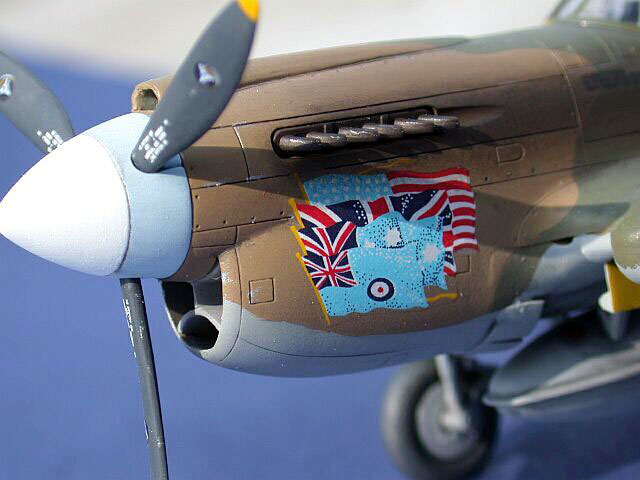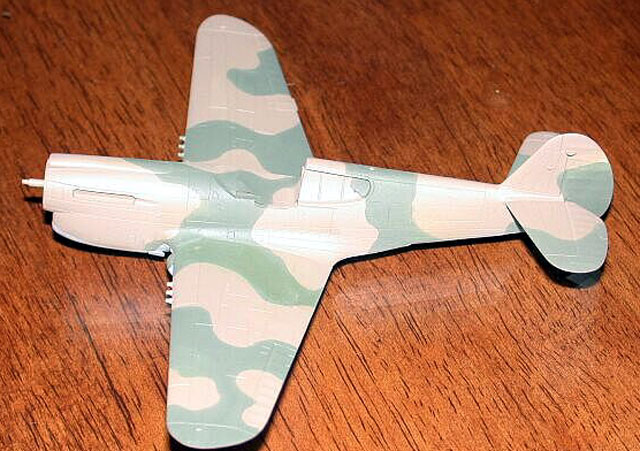|
Curtiss P-40E
Kittyhawk
by Darrell Carney
|

|
|
Curtiss P-40E Kittyhawk |

Academy's 1/72
scale P-40E is available online from
Squadron.com
This is the Academy 1/72 scale P-40E (kit number 1671.) Academy’s
little Warhawk sports nicely done engraved panel lines, a decent cockpit
with some generic molded in sidewall details and markings for three
different P-40s.

My model is done up in the kit markings for a RAAF Kitty Hawk from
the 77th Squadron in New Guinea, 1942. The other two options provided
are for an Aleutian Tiger and for the “Texas Longhorn” flown by First
Lt. John D. Landers in New Guinea, 1942.
Construction started with the cockpit that was painted and drybrushed to
pick out the details. I originally intended to have the canopy open and
spent a little extra time in the cockpit. After dry fitting the fuselage
together I found out that the canopy was too thick to properly slide
back in the open position. The canopy would not sit right opened up even
after a lot of work to try to thin it down. So, after much effort the
canopy was closed forever! Basic construction was completed with very
little difficulty with the overall the fit being very good.
Painting was begun with a primer coat of the underside sky gray. All my
painting was accomplished with Polly Scale acrylics and an Aztek A470
airbrush. The lower surfaces were then masked off using “Silly Putty”,
the kids toy that comes in a little plastic egg. This putty is very
pliable, holds it shape when formed around the model and is just sticky
enough to conform to the model without leaving any residue. The photo
shows the Silly Putty in action ready for the application of the second
topside color.

All three camouflage colors were lightened considerably for scale
effect. I’m fairly sure my colors wouldn’t pass muster against a FS
chart but look ok to me! The spinner was first airbrushed white then
masked and the blue band was applied. Using some artistic license, this
same blue was used on the wheels as well.

As mentioned earlier a lot of wasted effort was spent on the canopy.
After several Future dips the canopy and windscreen were painted, by
hand. I have yet to master masking and airbrushing canopies. I had kept
the mixtures of my topcoat colors through the entire process to ensure
good color matches for any topcoat touchups and for use on my canopy and
windscreen. The transparencies were not attached until the after the
final flat coats were applied.
 Panel
lines were accented with washes of dark brown and dark gray made by
mixing pastel chalk powder with water and dish soap. The model was then
given an airbrushed coat of Future in preparation for the RAAF decals. Panel
lines were accented with washes of dark brown and dark gray made by
mixing pastel chalk powder with water and dish soap. The model was then
given an airbrushed coat of Future in preparation for the RAAF decals.
Someone pointed out that the Academy decals do not provide the
aircraft serial number for this aircraft. Too late to turn back at this
point! The decals went down with no problems using MicroSet/Sol. I went
back and picked out the panel lines lost under the decals with the same
wash mixtures used earlier.

A coat of Polly Scale flat was airbrushed at this point and final
weathering was accomplished with dry pastel chalks; mixtures of browns
and grays to dirty things up a bit.
The exhaust stains were accomplished in the same manner. Some paint
chipping was added to heavy use panels and along the leading edges with
a sharpened silver artist pencil.
Academy's 1/72 scale P-40E is a nice little kit, especially for the
price I bought it for here in South Korea!
I wish I would have caught the missing serial sooner but I’ll have to
live with my anonymous Kitty Hawk!
Click on the thumbnails
below to view larger images:
Model, Images and Text Copyright © 2002 by
Darrell Carney
Page Created 22 August, 2002
Last Updated 04 June, 2007
Back to HyperScale
Main Page
Back to
Features Index
|
Home
| What's New |
Features |
Gallery |
Reviews |
Reference |
Forum |
Search